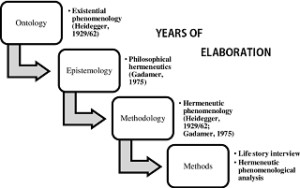
Phenomenology and historical hermeneutics
Any reading, however simple or complex, involves an interpretation, and in whatever culture the interpreter is based on language, especially writing for people who have gone beyond oral language, so we speak of text interpretation.
whatever culture the interpreter is based on language, especially writing for people who have gone beyond oral language, so we speak of text interpretation.
It is clear that the imaginary and the different languages, for example, now the media, have a differentiating influence, however they will still be based on that primary schooling of the different interpretants and it is still in the primary school the interpretation of texts.
We already said in the previous post that it starts with Socrates’ maieutics (act of giving ideas), not by chance the birth of the school as we know it today, then came the Platonic academic and the Aristotelian high school, the long period called “translatio studiorum” from the low and high middle ages, until reaching the Gutenberg press and the modern school, linked to modern enlightenment.
Contemporary hermeneutics, whose starting point for several authors is Schleiermacher (1768-1834) was contemporary with Hegel, but with direct influence from Kant and Fichte, he did not opt for idealistic subjectivism, and as a Lutheran religious he also escaped from Catholic orthodoxy
However, hermeneutics will find another soil in Franz Brentano, which until breaking with the Catholic scholastic vision (he was even a cleric), in 1871, he reinterprets the scholastic-Aristotelian intentionality “the intentional in-existence” (the reference is of Safranski) distinguishing two modes of being: the esse naturale, natural or real being located outside the subject who perceives it, and the esse intentionale, the mental or intentional being of the objects that exist immanent to the subject who knows it.
This philosophical digression is important to understand that in Franz Brentano and later in Husserl, hermeneutics has undergone a profound change, preserving its ontological root, thus maintaining the relationship to a content, but delves into the mental or psychological issue.
Husserl, a student of Franz Brentano, will cause another change in hermeneutics now towards the epistemological crisis of science in the mid-early 20th century, Husserl responds with a rupture to the Kantian dualism between the object and the knowing subject, with a question: “I exist , therefore, all the “no me” is a simple phenomenon and dissolves into phenomenal nexuses? ” (HUSSERL, 1992, p. 43).
The evolution of this thought will pass through Heidegger, a student of Husserl, who in Being and Time (1986), explaining that these elaborations since Plato and Aristotle were tied to natural phenomena: “The dominant representation in the West of the totality of nature (the world) it was, until the 17th century, determined by Platonic and Aristotelian philosophy … ”(page 86) and that now the question of Being should be taken up again, it is thus a big step in philosophical hermeneutics.
The maturity of this thought, elaborating the method of the hermeneutic circle is developed by Gadamer, for those who interpret “… it is not to take notice of what has been understood, but to elaborate possibilities projected in the understanding”, it is thus an opening in the preconceptions.
References
GADAMER, H.-G. (1989) Verdade e Método. Petrópolis (Brazil): Editora Vozes.
HEIDEGGER, M. (1986) Ser e Tempo. São Paulo: Vozes.
HEIDEGGER, M. (1987) Que é uma coisa? Lisboa: Edições 70. (pdf in english)
HUSSERL, E. (1992) A ideia da fenomenologia. Lisboa: Ediçoes 70.









